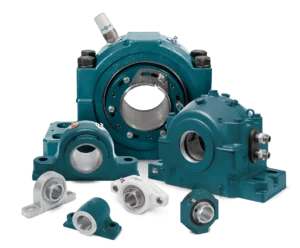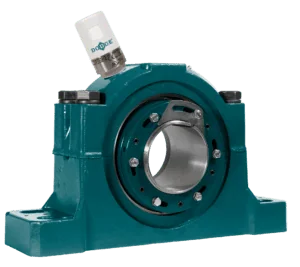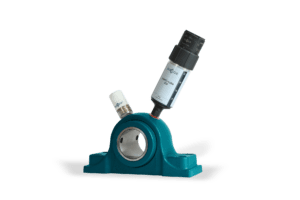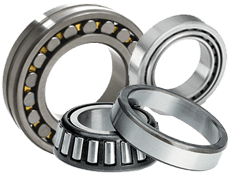Bearings are unsung heroes, quite literally bearing the weight of relentless motion in industrial systems. They play a critical role in transferring loads, reducing friction between moving parts, and facilitating smooth operation. Their failure can be a big problem– leading to downtime you don’t want or need.
One of the best ways to keep your bearings running is to incorporate automation into your industrial systems. From grain handling, to manufacturing, to mining and food production, chances are, there are bearings in your equipment that could stand to benefit from automation. The most common types of automation for bearings are temperature monitoring, vibration analysis, and lubrication systems.
How Do Bearings Work?
Bearings work in three ways– reducing friction, supporting loads, and facilitating the transfer of motion.
Reducing friction between moving parts enables efficient transfer of motion and protects other components of your industrial system from wear and tear. When two surfaces come into contact and slide against each other, friction is generated which can lead to energy loss, wear, and heat buildup. Bearings introduce a rolling element between the surfaces, allowing them to roll instead of sliding.
Bearings also support loads that are applied to rotating or moving parts, like shafts and axles. Because they distribute the weight over a larger area, they prevent excessive stress on individual components and ensure smooth operation even under heavy loads. Depending on the application, bearings can support radial loads (perpendicular to the axis of rotation), or axial loads (parallel to the axis of rotation).

Lastly, bearings facilitate the transfer of motion from one component to another. A common example would be as a part of a wheel. A bearing enables the rotation of a wheel around an axle while also supporting the vehicle’s weight. In a conveying system, you’ll find bearings around the shaft that rotates a pulley. In this way, bearings facilitate both the smooth movement of the pulley, and protect the equipment from the constant wear of the shaft rotation.
This concept also applies to gearboxes, allowing the transmission of rotational motion from the motor shaft to other components, while providing minimal friction. Bearings also provide support and stability to rotating shafts, preventing reflection or misalignment that could lead to excess vibration, noise, or premature failure.
There are many kinds of bearings, utilized in both unmounted and mounted bearing assemblies, designed for a variety of applications. Common types include ball, roller (spherical and tapered), needle, and thrust bearings, each of which offer different ranges of load capacity, speed tolerance, precision requirements, and temperature tolerance.
How Can Automation Prevent Failure?
Bearing failures can happen unexpectedly, which will cause disruption in your operations and can require urgent repairs. Even if you practice traditional maintenance practices, such as routine inspections or time-based replacements, you still might not catch the problem in time.
This is why automation can prevent catastrophe in your facility. By using advanced sensors and monitoring systems, you can track crucial bearing parameters like temperature, vibration, and lubrication condition. This will alert you to potential issues before they become a problem, and empowers maintenance teams to take proactive measures before downtime situations occur.
Automation, also called continuous monitoring, can help ensure worker safety as well. Lubricating bearings can be a dangerous job, often requiring workers to reach into small spaces with limited visibility. With automatic lubrication, all that needs to be done is refill the accessible pump with grease. Depending on your application, you may also avoid lock-out-tag-out procedures, because you may not need to turn off machinery.
Monitoring Your Bearings


Temperature is a key indicator of bearing health. Excessive heat is often a sign of impending failure. Automation enables real-time temperature monitoring of bearings, allowing for early detection of unusual heat patterns. Automated systems can be set for certain heat thresholds, triggering alerts when bearing temperatures exceed safe limits.
Another important aspect to monitor is vibration analysis. Automated systems can analyze vibration data in real time, distinguishing between normal operating conditions and abnormal vibrations that may be caused by misalignment, imbalance, or bearing defects.
But one of the most important things to monitor is your level and type of lubrication. Over 70% of mounted bearings in the USA are manually lubricated, and keeping them at the right level of lubrication is a constant challenge for many. Automatic lubrication systems remove this challenge, ensuring consistent and adequate lubrication. This prevents over-lubrication and under-lubrication, resulting in enhanced performance and a longer bearing lifespan.
Premier Options for Bearing Automation
Dodge Industrial provides a variety of automation options, allowing users to easily monitor the overall health of their equipment. This means you can operate more safely, track potential issues, and proactively schedule maintenance before your system goes down.
For example, their OPTIFY™ condition monitoring platform helps automate maintenance plans, tying together sensors and automatic grease lubricators while also providing data analytics and predictive inventory functions.
When it comes to automatic lubrication systems, you can’t go wrong with the Dodge Intelli-Lube™ product. Intelli-Lube is the premier automatic, single-point lubricator solution that replaces the manual process of lubricating mounted and motor bearings. It can also seamlessly connect with their OPTIFY condition monitoring platform for worry-free operations.


Intelli-Lube lets you work smarter, not harder. Features include a simplified product selection with their PT Wizard tool, a wide operating temperature range, consistent grease delivery, remote mount options, and Bluetooth capabilities for wireless connectivity. When combined with Dodge OPTIFY Performance Sensors and OPTIFY remote condition monitoring program, these products can optimize your plant-wide cartridge inventory, offer temperature and speed monitoring, and send automated replacement notifications.
80% of mounted bearing failures are lubricant-related. Ensure your facility can avoid these failures by utilizing Intelli-lube.
How IBT Can Assist with Bearing Automation
IBT carries a large variety of Dodge products, including OPTIFY monitoring systems and Intelli-Lube. Our Automatic Lubrication Division can also help answer questions and evaluate your current system for optimization. They specialize in designing automatic lubrication systems using a comprehensive collection of pumps, metering valves, controllers and accessories to deliver accurate and timely lubrication.
Contact us to learn more! You can also find out more about Dodge capabilities and products here, or shop our extensive inventory of lubricants on ShopIBT.Com.


Shop All of Dodge’s Bearing and Power Transmission Products
Check out ShopIBT.com to find the right bearing and power transmission products for your needs!





